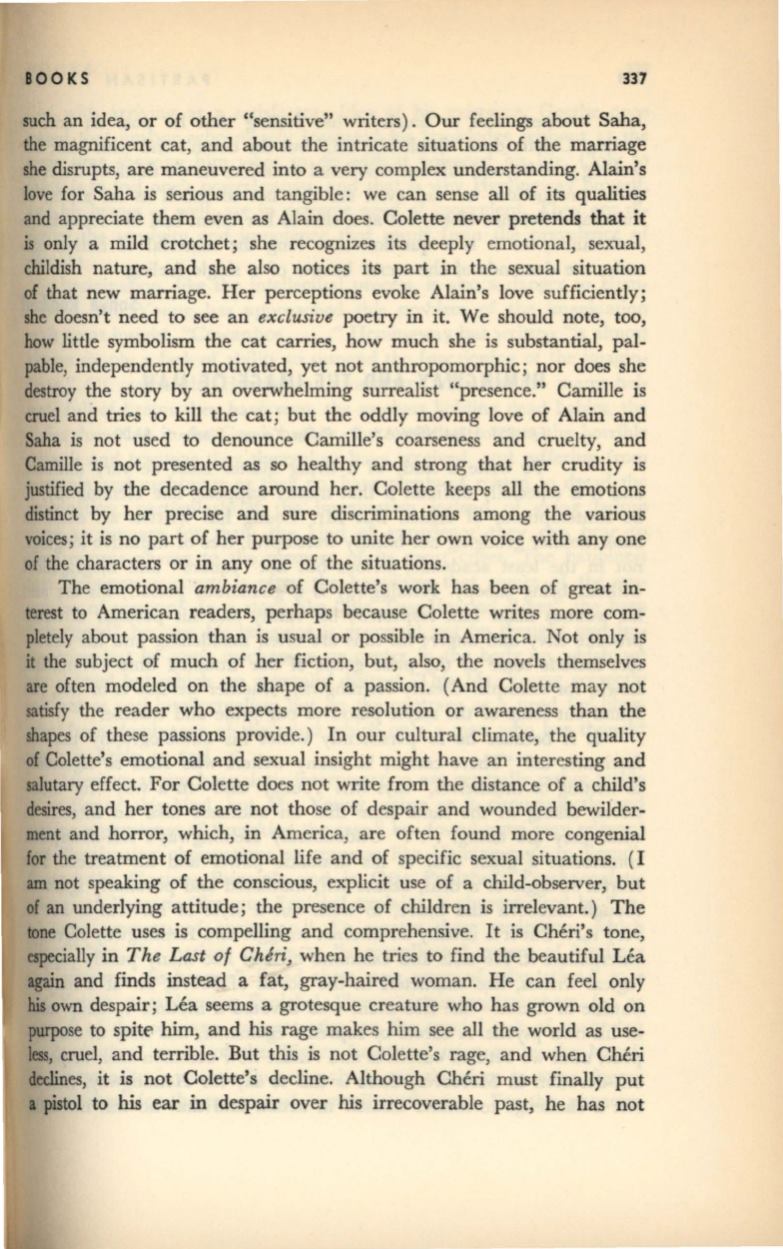
lOOKS
337
such an idea, or of other "sensitive" writers). Our feelings about Saha,
the magnificent cat, and about the intricate situations of the marriage
she disrupts, are maneuvered into a very complex understanding. Alain's
love for Saha is serious and tangible: we can sense all of its qualities
and appreciate them even as Alain does. Colette never pretends that it
is
only a mild crotchet; she recognizes its deeply emotional, sexual,
childish nature, and she also notices its part in the sexual situation
of that new marriage. Her perceptions evoke Alain's love sufficiently;
she doesn't need to see an
exclusiue
poetry in it. We should note, too,
how
little symbolism the cat carries, how much she is substantial, pal–
pable, independently motivated, yet not anthropomorphic; nor does she
destroy the story by an overwhelming surrealist "presence." Camille is
cruel and tries to kill the cat; but the oddly moving love of Alain and
Saha
is not used to denounce Camille's coarseness and cruelty, and
Camille is not presented as so healthy and strong that her crudity is
justified by the decadence around her. Colette keeps all the emotions
distinct by her precise and sure discriminations among the various
voices; it is no part of her purpose to unite her own voice with anyone
of the characters or in anyone of the situations.
The emotional
ambiance
of Colette's work has been of great in–
terest to American readers, perhaps because Colette writes more com–
pletely about passion than is usual or possible in America. Not only is
it
the subject of much of her fiction, but, also, the novels themselves
are often modeled on the shape of a passion. (And Colette may not
satisfy the reader who expects more resolution or awareness than the
shapes of these passions provide.) In our cultural climate, the quality
of Colette's emotional and sexual insight might have an interesting and
salutary effect. For Colette does not write from the distance of a child's
desires, and her tones are not those of despair and wounded bewilder–
ment and horror, which, in America, are often found more congenial
for the treatment of emotional life and of specific sexual situations. (I
am not speaking of the conscious, explicit use of a child-observer, but
of
an underlying attitude; the presence of children is irrelevant.) The
tone Colette uses is compelling and comprehensive. It is Cheri's tone,
especially in
The Last of Cheri,
when he tries to find the beautiful Lea
again and finds instead a fat, gray-haired woman. He can feel only
his
own despair; Lea seems a grotesque creature who has grown old on
purpose to spitt"
him,
and his rage makes him see all the world as use–
less,
cruel, and terrible. But this is not Colette's rage, and when Cheri
declines, it is not Colette's decline. Although Cheri must finally put
a pistol to
his
ear
in
despair over his irrecoverable past, he has not


